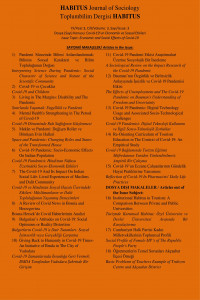Abstract
Persons with disabilities often live in the margins, being excluded by the system as well by the impairments they experience. A pandemic such as COVID-19, further pushes them into invisibility, unless active attempts are made to consider them as entitled to the same care as others. This paper explores the manner in which pandemic pushes people with disabilities further into the margins, thus experiencing exclusion. The changes that the pandemic has brought in comes with a price that all people have to pay, However the social and economic costs that people with disabilities experience are uniquely different. The article focuses on economic and social marginalisation that ensues the pandemic and the state response and the struggles that PWD had to experience. Further this is compounded by social exclusion and ‘othering’ that not only complicates their life, but also worsens stigmatising practices. The paper discusses the interplay of the macro context, the market and life within the home that has altered during the pandemic.
Keywords
Thanks
The authors wish to acknowledge the participants and Ms. Chitra Lakshman
References
- Hossain, M. S., Ferdous, S., and Siddiqee, M. (2020). Mass panic during COVID-19 outbreak–A perspective from Bangladesh as a high-risk country. J. Biomed. Analyt. 3 (2), 1–3.
- ICF: An Overview. PTC Working Paper. https://www.cdc.gov/nchs/data/icd/icfoverview_finalforwho10sept.pdf (Access 12.02.22).
- John, D, Narassima, M.S, Menon J, et al. (2021). Estimation of the economic burden of COVID-19 using disability-adjusted life years (DALYs) and productivity losses in Kerala, India: a model-based analysis. BMJ Open, https://bmjopen.bmj.com/content/11/8/e049619 (Access 07.02.22).
- Kidd, S., Wapling, L., Schjoedt, R. and Gelders, B. (2019). Leaving no-one behind: building inclusive social protection systems for persons with disabilities. Development Pathways.
- Kühn, M. (2014): Peripheralization: Theoretical Concepts Explaining Socio-Spatial Inequalities, European Planning Studies, DOI: 10.1080/09654313.2013.862518, http://dx.doi.org/10.1080/09654313.2013.862518 (Access on 14.02.22).
- McDougall J, Wright V, Rosenbaum P. (2010). The ICF model of functioning and disability: incorporating quality of life and human development. Developmental Neurorehabilitation., 13(3):204-211. DOI: 10.3109/17518421003620525
- Meaney-Davis, J. (2020) The financial and economic impacts of the COVID-19 pandemic on people with disabilities in low- and middle-income countries, Disability Inclusion Helpdesk Research Report No. 42. London, UK: Disability Inclusion Helpdesk.
- Ozili, P. K., and Arun, T. (2020). Spillover of COVID-19: impact on the global economy. https://papers.ssrn.com/sol3/papers.cfm?abstract_id3562570 (Access 05.02.22).
- Mowat, J. G. (2015). Towards a new conceptualisation of marginalisation. European Educational Research Journal, 14(5), 454–476. https://doi.org/10.1177/1474904115589864 (Access on 15.02.22).
- Messiou K. (2012). Collaborating with children in exploring marginalisation: An approach to inclusive education. International Journal of Inclusive Education 16(12): 1311–1322.
- Rasul, G. (2020). A framework for improving policy priorities in managing COVID-19 challenges in developing countries. Frontiers in Public Health. 8, https://doi.org/10.3389/fpubh.2020.589681 (Access 03.02.22).
- Rasul G, Nepal AK, Hussain A, et. al. (2021). Socio-Economic Implications of COVID-19 Pandemic in South Asia: Emerging Risks and Growing Challenges. Frontiers in Sociology. https://doi.org/10.3389/fsoc.2021.629693 (Access 05.02.22).
- UNDESA (United Nations Department of Economic and Social Affairs) (2019). Disability and Development Report: realising the Sustainable Development Goals by, for and with persons with disabilities. https://social.un.org/publications/UN-Flagship-Report-Disability-Final.pdf (Access 05.02.22).
- Wacquant, L. (2008). Urban Outcasts. A comparative Sociology of Advanced Marginality, Cambridge: Polity Press.
Abstract
Persons with disabilities often live in the margins, being excluded by the system as well by the impairments they experience. A pandemic such as COVID-19, further pushes them into invisibility, unless active attempts are made to consider them as entitled to the same care as others. This paper explores the manner in which pandemic pushes people with disabilities further into the margins, thus experiencing exclusion. The changes that the pandemic has brought in comes with a price that all people have to pay, However the social and economic costs that people with disabilities experience are uniquely different. The article focuses on economic and social marginalisation that ensues the pandemic and the state response and the struggles that PWD had to experience. Further this is compounded by social exclusion and ‘othering’ that not only complicates their life, but also worsens stigmatising practices. The paper discusses the interplay of the macro context, the market and life within the home that has altered during the pandemic.
Keywords
References
- Hossain, M. S., Ferdous, S., and Siddiqee, M. (2020). Mass panic during COVID-19 outbreak–A perspective from Bangladesh as a high-risk country. J. Biomed. Analyt. 3 (2), 1–3.
- ICF: An Overview. PTC Working Paper. https://www.cdc.gov/nchs/data/icd/icfoverview_finalforwho10sept.pdf (Access 12.02.22).
- John, D, Narassima, M.S, Menon J, et al. (2021). Estimation of the economic burden of COVID-19 using disability-adjusted life years (DALYs) and productivity losses in Kerala, India: a model-based analysis. BMJ Open, https://bmjopen.bmj.com/content/11/8/e049619 (Access 07.02.22).
- Kidd, S., Wapling, L., Schjoedt, R. and Gelders, B. (2019). Leaving no-one behind: building inclusive social protection systems for persons with disabilities. Development Pathways.
- Kühn, M. (2014): Peripheralization: Theoretical Concepts Explaining Socio-Spatial Inequalities, European Planning Studies, DOI: 10.1080/09654313.2013.862518, http://dx.doi.org/10.1080/09654313.2013.862518 (Access on 14.02.22).
- McDougall J, Wright V, Rosenbaum P. (2010). The ICF model of functioning and disability: incorporating quality of life and human development. Developmental Neurorehabilitation., 13(3):204-211. DOI: 10.3109/17518421003620525
- Meaney-Davis, J. (2020) The financial and economic impacts of the COVID-19 pandemic on people with disabilities in low- and middle-income countries, Disability Inclusion Helpdesk Research Report No. 42. London, UK: Disability Inclusion Helpdesk.
- Ozili, P. K., and Arun, T. (2020). Spillover of COVID-19: impact on the global economy. https://papers.ssrn.com/sol3/papers.cfm?abstract_id3562570 (Access 05.02.22).
- Mowat, J. G. (2015). Towards a new conceptualisation of marginalisation. European Educational Research Journal, 14(5), 454–476. https://doi.org/10.1177/1474904115589864 (Access on 15.02.22).
- Messiou K. (2012). Collaborating with children in exploring marginalisation: An approach to inclusive education. International Journal of Inclusive Education 16(12): 1311–1322.
- Rasul, G. (2020). A framework for improving policy priorities in managing COVID-19 challenges in developing countries. Frontiers in Public Health. 8, https://doi.org/10.3389/fpubh.2020.589681 (Access 03.02.22).
- Rasul G, Nepal AK, Hussain A, et. al. (2021). Socio-Economic Implications of COVID-19 Pandemic in South Asia: Emerging Risks and Growing Challenges. Frontiers in Sociology. https://doi.org/10.3389/fsoc.2021.629693 (Access 05.02.22).
- UNDESA (United Nations Department of Economic and Social Affairs) (2019). Disability and Development Report: realising the Sustainable Development Goals by, for and with persons with disabilities. https://social.un.org/publications/UN-Flagship-Report-Disability-Final.pdf (Access 05.02.22).
- Wacquant, L. (2008). Urban Outcasts. A comparative Sociology of Advanced Marginality, Cambridge: Polity Press.
Details
| Primary Language | English |
|---|---|
| Subjects | Sociology |
| Journal Section | Research Articles |
| Authors | |
| Early Pub Date | March 27, 2022 |
| Publication Date | March 28, 2022 |
| Published in Issue | Year 2022 Volume: 3 Issue: 3 |



